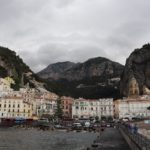The Apostles of Campania

Pompei, in the region of Campania, was our next stop after San Giovanni Rotondo. Arriving on Sunday afternoon, the pilgrims first took a guided tour of the ruins of the city that was destroyed by an eruption of the nearby volcano Vesuvius in 79 A.D. The group then walked a short distance to the magnificent Pontifical Shrine of the Blessed Virgin of the Rosary of Pompei, a minor basilica and the cathedral of that area. The grand edifice was commissioned in the latter half of the 19th century by Blessed Bartolo Longo, a former Satanic priest who became, as Pope St. John Paul II named him, the “Apostle of the Rosary”.

The origins of the Basilica are tied up with those of the miraculous image of Our Lady of the Rosary that hangs above the high altar. The painting was given to Blessed Bartolo in 1875, who placed it in a run-down church that he was repairing. Miracles began to take place immediately, and the Bishop of Nola suggested that Blessed Bartolo construct a larger church. Hence, work began on the current structure in 1876, its consecration taking place in 1891. It was reconsecrated as a basilica in 1901 and expanded in 1939. The pilgrims venerated Blessed Bartolo’s relics that rest in a chapel there.

We checked into Vico Equense that evening, just across the bay from Naples. It is probably safe to say that the next day set a new standard for Monday mornings. We took off early for the Amalfi coast, Italy’s version of Highway 1, and were awed by a stunning coastal drive along dizzying cliff-faces that stand high above the sparkling blue waters of the Mediterranean. But the natural beauty that we saw paled in comparison with the real jewel of that region, the town of Amalfi’s Cathedral of St. Andrew, where the Apostle’s relics are housed. There, at a side altar, we celebrated a votive Mass of St. Andrew.

Our next destination was the town of Ravello, in the center of which rises the Cathedral of St. Pantaleon, a doctor from what is now Turkey who was martyred in the 4th century under Diocletian. His blood, like that of St. Januarius whom we would see in Naples the next day, has been preserved and miraculously liquefies on his July feast day. Usually, we were told, it coagulates again about a week later, but this year it has remained in a liquid state for longer than normal, and we were privileged to venerate the liquefied blood that is held in a vial in the Cathedral.

Despite a bout of bad weather that rolled into Ravello that afternoon and left us royally drenched, a vibrant rainbow accompanied us on the long drive home, and as we pulled into our home base of Vico Equense, it lingered peacefully over the towns that lie near the city of Naples where we would head for our next and last day in Italy.
October 30, 2018












